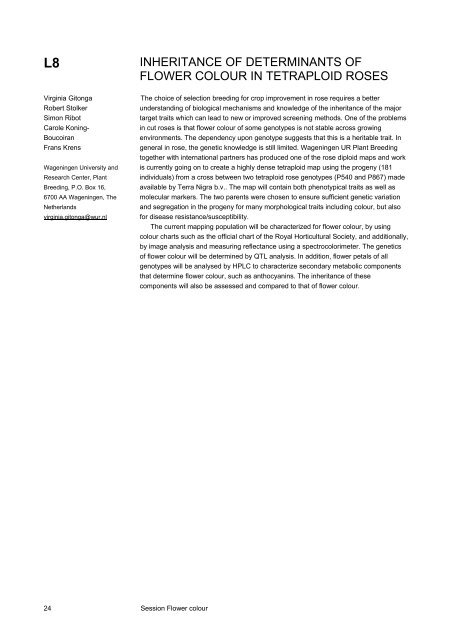XXIIIrd International Eucarpia symposium, Section Ornamentals ...
XXIIIrd International Eucarpia symposium, Section Ornamentals ...
XXIIIrd International Eucarpia symposium, Section Ornamentals ...
Create successful ePaper yourself
Turn your PDF publications into a flip-book with our unique Google optimized e-Paper software.
L8<br />
Virginia Gitonga<br />
Robert Stolker<br />
Simon Ribot<br />
Carole Koning-<br />
Boucoiran<br />
Frans Krens<br />
Wageningen University and<br />
Research Center, Plant<br />
Breeding, P.O. Box 16,<br />
6700 AA Wageningen, The<br />
Netherlands<br />
virginia.gitonga@wur.nl<br />
INHERITANCE OF DETERMINANTS OF<br />
FLOWER COLOUR IN TETRAPLOID ROSES<br />
The choice of selection breeding for crop improvement in rose requires a better<br />
understanding of biological mechanisms and knowledge of the inheritance of the major<br />
target traits which can lead to new or improved screening methods. One of the problems<br />
in cut roses is that flower colour of some genotypes is not stable across growing<br />
environments. The dependency upon genotype suggests that this is a heritable trait. In<br />
general in rose, the genetic knowledge is still limited. Wageningen UR Plant Breeding<br />
together with international partners has produced one of the rose diploid maps and work<br />
is currently going on to create a highly dense tetraploid map using the progeny (181<br />
individuals) from a cross between two tetraploid rose genotypes (P540 and P867) made<br />
available by Terra Nigra b.v.. The map will contain both phenotypical traits as well as<br />
molecular markers. The two parents were chosen to ensure sufficient genetic variation<br />
and segregation in the progeny for many morphological traits including colour, but also<br />
for disease resistance/susceptibility.<br />
The current mapping population will be characterized for flower colour, by using<br />
colour charts such as the official chart of the Royal Horticultural Society, and additionally,<br />
by image analysis and measuring reflectance using a spectrocolorimeter. The genetics<br />
of flower colour will be determined by QTL analysis. In addition, flower petals of all<br />
genotypes will be analysed by HPLC to characterize secondary metabolic components<br />
that determine flower colour, such as anthocyanins. The inheritance of these<br />
components will also be assessed and compared to that of flower colour.<br />
24 Session Flower colour














